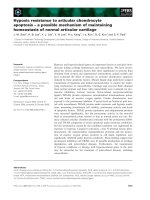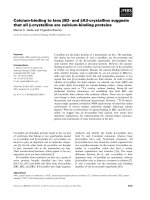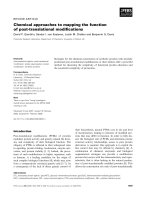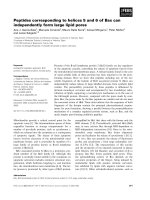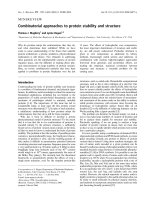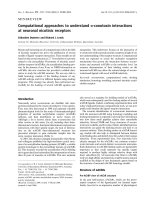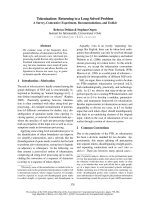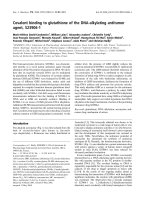báo cáo khoa học: " Community capacity to acquire, assess, adapt, and apply research evidence: a survey of Ontario’s HIV/AIDS sector" pot
Bạn đang xem bản rút gọn của tài liệu. Xem và tải ngay bản đầy đủ của tài liệu tại đây (225.46 KB, 6 trang )
SHOR T REPOR T Open Access
Community capacity to acquire, assess, adapt,
and apply research evidence: a survey of
Ontario’s HIV/AIDS sector
Michael G Wilson
1,2,3
, Sean B Rourke
1,4,5*
, John N Lavis
2,3,6,7
, Jean Bacon
1
and Robb Travers
8,9
Abstract
Background: Community-based organizations (CBOs) are important stakeholders in health systems and are
increasingly called upon to use research evidence to inform their advocacy, program planning, and service delivery.
To better support CBOs to find and use research evidence, we sought to assess the capacity of CBOs in the HIV/
AIDS sector to acquire, assess, adapt, and apply research evidence in their work.
Methods: We invited executive directors of HIV/AIDS CBOs in Ontario, Canada (n = 51) to complete the Canadian
Health Services Research Foundation’s “Is Research Working for You?” survey.
Findings: Based on responses from 25 organizations that collectively provide services to approximately 32,000
clients per year with 290 full-time equivalent staff, we found organizational capacity to acquire, assess, adapt, and
apply research evidence to be low. CBO strengths include supporting a culture that rewards flexibility and quality
improvement, exchanging information within their organization, and ensuring that their decision-making processes
have a place for research. However, CBO Executive Directors indicated that they lacked the skills, time, resources,
incentives, and links with experts to acquire research, assess its quality and reliability, and summarize it in a user-
friendly way.
Conclusion: Given the limited capacity to find and use research evidence, we recommend a capacity-building
strategy for HIV/AIDS CBOs that focuses on providing the tools, resources, and skills needed to more consistently
acquire, assess, adapt, and apply research evidence. Such a strategy may be appro priate in other sectors and
jurisdictions as well given that CBO Executive Directors in the HIV/AIDS sector in Ontario report low capacity
despite being in the enviable position of having stable government infrastructure in place to support them,
benefiting from long-standing investment in capacity building, and being part of an active provincial network.
CBOs in other sectors and jurisdictions that have fewer supports may have comparable or lower capacity. Future
research should examine a larger sample of CBO Executive Directors from a range of sectors and jurisdictions.
Findings
Community-based organizations (CBOs) are important
stakeholders in the health sector [1,2] as they not only
provide a wide spectrum of programs and services to
the members of their commun ity but also play an advo-
cacy role for broader system-level supports. As we have
outlined in more detail in a previous paper [3], CBOs
are typically not-for-profit organizations that: are guided
byaspecificmission(i.e.,anoverallgoal)shapedby
commonly held values within the community they serve;
have a governance structure consisting of board mem-
bers elected from the members in the community; and
deliver a specific set of programs or services that are
shaped by the mission and values of the organization.
Because they are key health system stakeholders, it is
important to support their capacity to find and use rele-
vant and high-quality research evidence. Doing so will
help ensure that programs, services, and advocacy are
informed by the best available evidence.
However, there are many potential challenges related
to research use. Barriers that have been consistently
identified across sectors include: the comple xity of
* Correspondence:
1
The Ontario HIV Treatment Network, Toronto, Canada
Full list of author information is available at the end of the article
Wilson et al. Implementation Science 2011, 6:54
/>Implementation
Science
© 2011 Wilson et al; licensee BioMed Central Ltd. This is an Open Access article distributed under the terms of the Creative Commons
Attribution License (http://creativecom mons.org/licenses/by/2.0), w hich permits unrestricted use, distribution, and repro duction in
any medium, provided the original work is properly cited.
research evidence, organizational barriers, lack of avail-
able time, poor access to current literature, lack of
timely research, lack of e xperience and skills for critical
appraisal, unsupportive culture for research, lack of
actionable messages in research reports, and limited
resources for implementation [4-8]. Given these barriers,
it is not surprising that a lack of uptake of research evi-
dence has been noted in many different sectors [9-13].
While there are strategies for supporting the use of
research by managers of healthcare organizations and by
policy makers in government [14,15], there is still an
important gap in the availability of a specific strategy for
CBOs [3]. Many existing strategies fo r supporting the
useofresearchevidencearebasedonexperienceand
anecdotal evidence r ather than on rigorous evidence of
effects [8,14,16]. Moreover, strategies designed for sup-
porting the use of research evidence by healthcare orga-
nizations and governments may not be relevant to the
specific contexts and capacity of CBOs. The transferabil-
ity of these strategies to CBOs is difficult to determine
without first collecting evidence about their current
capacity to find and use research evidence and then
grappling with how to align capacity-building strategies
with local realities [17-21].
In order to begin to fill this gap, we conducted an
assessment of the capacity of HIV/AIDS CBOs in one
Canadian jurisdiction (Ontario). The role of CBOs is
particularly important for addressing the HIV/AIDS epi-
demic in Ontario as approximat ely half of all people liv-
ing with HIV/AIDS in Canada reside in that province
[22,23]. The province has a strong network of HIV/
AIDS CBOs to respond to the local HIV epidemic, with
51 organizations serving 19 different regions at the time
of this study (there are now 46 organizations) [24]. As
such, this network provides essential on-the-ground
support for people living with HIV/AIDS, especially for
the most vulnerable [25].
We invited Executive Directors of HIV/AIDS CBOs
that are funded by the AIDS Bureau of the O ntario
Ministry of Health and Long-Term Care and members
of the Ontario AIDS Network (n = 51) to complete an
online survey. We asked each Executive Director to
work with one or more managers and front-line staf f to
complete the survey, allowing them to respond to areas
that they are most knowledgeable about but also be
informed by the specific k nowledge of other managers
and staff.
The CBO Executive Directors in Ontario were invited
to complete an adapted version of the Canadian Health
Services Research Foundation’ s “ Is Research Working
for You?” survey, which has been p reviously validated
[26,27]. The survey is organized into four areas of
assessment: (1) Acquire: Can your organization find and
obtain the research findings it needs?; (2) Assess:Can
your organization assess research findings to ensure
they are reliable, relevant, and applicable to you?; (3)
Adapt: Can your organization present the research to
decision makers in a useful way?; and (4) Apply:Are
there skills, structures, processes, and a culture in your
organization to promote and use research findings in
decision making [27]? Each domain is then broken
down into subsections that ask how well their organiza-
tion performs specific tasks, and each question uses a
five-point Likert scale (question anchors are 1 = Don’ t
do, 2 = Do poorly, 3 = Do inconsistently, 4 = Do with
some consistency, and 5 = Do well).
We analyzed the results of the survey by calculating
response frequencies for each question. We did not con-
duct statistical comparisons between organizations due
to the small sample available for the survey. Ethics
approval was obtained from the University of Toronto
to complete this research.
Executive Directors from 25 organizations completed
the survey (response rate = 49%). These organizations
collectively provide services to approxima tely 32,000 cli-
ents per year with 290 full-time equival ent staff. Partici-
pant/organizational characteristics are summarized in
Table 1, and the results for each question are presented
in Tables 2, 3, 4 to 5. The survey respondents were pre-
dominantly from organizations with an exclusive focus
on HIV/AIDS. In addit ion, the sample appears balanced
based on region served (approximately half were based
in the greater Toronto area) and includes organizations
with varying scale (as measured by the number of full-
time equivalent staff) and service volume (as measured
by the number of clients served each year). Lastly, the
organizations included in our sample provide HIV/AIDS
services to a broad array of populations, including
women, youth, men who have sex with men, injection
drug users, specific ethno-racial communities, as well as
people living with HIV/AIDS.
Overall, we found organizational ca pacity to acquire,
assess, adapt, and apply research evidence to be low,
with a couple of notable exceptions where the majority
of organizations provided ratings of “Do with some con-
sistency” or “Do well.” Capacity for applying research
evidence appears to be relatively strong, with approxi-
mately half of organizations indicating they “Do with
some consistency” or “Do well” on all but two questions
(related to time and engaging on-staff researchers) for
the subdomain related to whether their decision-making
process es have a place for research (Table 5, subsection
VII). In addition, most CBOs indicated that they have a
corporate culture that is supportive of research use (64%
selected “Do with some consistency” or “Do well”).
Few organizations rated any of the questions related to
acquiring, assessing, or adapting research evidence
higher than “
Inconsistent.” Areas
of relative strength
Wilson et al. Implementation Science 2011, 6:54
/>Page 2 of 6
include identifying research evidence through peer net-
works, “grey” literature reports, and through websites.
Capacity was lowest for the domains related to: acquir-
ing research (subsection I); assessing the reliability, qual-
ity, relevance, and applicability of research evidence
(subsections III and IV); and summarizing results in a
user-friendly way (s ubsection V). A higher proportion of
organizations selected the “Don’ tdo” or “ Do poorly”
response options in these domains. Overall, the results
indicate that CBOs are not only limited in skilled staff
with time, incentive, and resources for summarizing
results in a user-friendly way and assessin g the qua lity
and reliability of research, but they also have limited
arrangements with external experts to help them.
This study gives initial insight into the capacity of
CBOs to acquire, assess, adapt, and apply research in
their organizations, which can provide a starting point
for developing their capacity to find and use research
evidence. Efforts to build capacity among CBOs should
also draw on key facilitators for supporting the use of
research evidence that have been cited for other groups
of stakeholders, such as ongoing interactions between
researchers, managers, a nd policy makers and ensuring
research is available in a timely manner (e.g.,through
searchable databases of research syntheses) [7]. In addi-
tion, many strategies to s upport the use of research evi-
dence highlight the importance of clear summaries that
are tailored to the specific audience and highlight the
take-home messages from research [7,8,21,28,29].
The primary strength of this study is that it provides a
baseline assessment of CBO capacity to acquire, assess,
adapt, and apply research, which can be used for identi-
fying areas for future capacity-building strategies. In
Table 1 Participant characteristics
Characteristic n (%)
Organization type
AIDS service organization 23 (92%)
Organization with a mandate beyond HIV 2 (8%)
Region
GTA 13 (52%)
Non-GTA 12 (48%)
Number of FTE staff (organizational capacity)
<5 6 (24%)
5-10 10 (40%)
>10 9 (36%)
Number of clients served (service demand)
0-250 11 (44%)
251-750 8 (28%)
>750 6 (24%)
Ratio of FTEs to clients served
0-50 12 (44%)
51-75 7 (28%)
>76 6 (24%)
Populations served
a
People living with HIV/AIDS 25 (100%)
Women 22 (88%)
Youth 21 (84%)
Men who have sex with men 21 (84%)
Injection drug users 17 (68%)
Specific ethno-racial communities 18 (72%)
Other
b
6 (24%)
a
Response options were not mutually exclusive;
b
Other populations provided
by respondents were homeless/drop-ins, substance users other than injection
drug users, prisoners and ex-prisoners, transient persons, Aboriginal
communities, and transgendered populations.
GTA = greater Toronto area; FTE = full-time equivalent.
Table 2 Capacity to acquire research evidence*
Domain subsection Factors considered Don’t
do
Do
poorly
Do
inconsis-
tently
Do with some
consistency
Do
well
No
answer
I. Are we able to acquire
research?
1. Skilled staff for research 2 (8%) 7 (28%) 7 (28%) 4 (16%) 1 (4%) 4 (16%)
2. Time for research 5 (20%) 9 (36%) 6 (30%) 0 (0%) 0 (0%) 5 (20%)
3. Incentives for acquiring research 3 (12%) 5 (20%) 7 (28%) 7 (28%) 1 (4%) 2 (8%)
4. Resources to acquire research 7 (28%) 6 (24%) 5 (20%) 2 (8%) 0 (0%) 5 (20%)
5. Links with experts who search for research,
monitor research, or do research
8 (32%) 4 (16%) 7 (28%) 3 (12%) 1 (4%) 2 (8%)
II. Are we looking for research
in the right places?
1. Peer-reviewed journals 3 (12%) 3 (12%) 8 (32%) 5 (20%) 2 (8%) 4 (16%)
2. Non-journal reports/grey literature 1 (4%) 3 (12%) 7 (28%) 9 (36%) 1 (4%) 4 (16%)
3. Databases 8 (32%) 4 (16%) 7 (28%) 3 (12%) 0 (0%) 3 (12%)
4. Websites 0 (0%) 2 (8%) 10 (40%) 10 (40%) 0 (0%) 3 (12%)
5. Working with researchers through formal
and informal networking
5 (20%) 2 (8%) 6 (24%) 6 (24%) 2 (8%) 4 (16%)
6. Hosting researchers 4 (16%) 4 (16%) 5 (20%) 5 (20%) 4 (16%) 3 (12%)
7. Peer networks 0 (0%) 1 (4%) 5 (20%) 12 (48%) 4 (16%) 3 (12%)
*Results correspond to the number and percent of organizations included in the study selecting each response option.
Wilson et al. Implementation Science 2011, 6:54
/>Page 3 of 6
addition, the data from this study can be used in future
evaluations of organizational capacity after capacity-
building initiatives have been implemented. However,
the results should be interpreted with caution given the
low response rate and the small sample size. In addition,
the generaliza bility of our results to other Canadian and
international jurisdictions may be limited as we only
surveyed organizations in one Canadian jurisdiction.
Given the limited capacity to find and use research
evidence, we recommend a capacity-building strategy for
HIV/AIDS CBOs that focuse s on providing the tools,
resources, and skills needed to help CBOs more consis-
tently acquire, assess, adapt, and apply research evi-
dence. Such a strategy may also be appropriate in other
sectors a nd jurisdictions given that CBO Executive
Directors in the HIV/ AIDS sector in Ontario report low
capacity despite being in the en viable position of having
stable government infrastructure in place to support
them, benefiting from long-standing investment in capa-
city building, and being part of an active provincial net-
work. CBOs in other sec tors and jurisdictions that have
fewer supports may have comparable or lower capacity.
Capacity building does not mean that CBOs need to
do everything themselves. For instance, capacity building
can focus on efforts to facilitate “pu ll” [28], s uch as
developing and maintaining “one-stop shopping” web-
sites that provide access to high-quality and relevant
systematic reviews of the literature with user-friendly
Table 3 Capacity to assess research evidence
Domain subsection Factors considered Don’t
do
Do
poorly
Do
inconsistently
Do with
some
consistency
Do
well
No
answer
III. Can we tell if the
research is reliable and of
high quality?
1. Staff have critical appraisal skills for evaluating
the quality of research
6 (24%) 6 (24%) 8 (32%) 4 (16%) 0 (0%) 1 (4%)
2. Staff have critical appraisal skills for evaluating
the reliability of research
8 (32%) 5 (20%) 5 (20%) 3 (12%) 1 (4%) 3 (12%)
3. Links with external experts who use critical
appraisal skills and tools to evaluate the quality
and reliability of research
7 (28%) 6 (24%) 4 (16%) 3 (12%) 2 (8%) 3 (12%)
IV. Can we tell if the
research is relevant and
applicable?
1. Ability of staff to relate research to their
organization
2 (8%) 6 (24%) 8 (32%) 6 (24%) 2 (8%) 1 (4%)
2. Links with external experts to help determine
whether research is relevant to the organization
8 (32%) 7 (28%) 5 (20%) 2 (8%) 0 (0%) 3 (12%)
*Results correspond to the number and percent of organizations included in the study selecting each response option.
Table 4 Capacity to adapt research evidence
Domain subsection Factors considered Don’t
do
Do
poorly
Do
inconsis-
tently
Do with some
consistency
Do
well
No
answer
V. Can we summarize the results in
a user-friendly way?
Enough skilled staff with time, incentive,
and resources to:
1. present research results concisely and
in accessible language
7 (28%) 7 (28%) 6 (24%) 2 (8%) 1 (4%) 2 (8%)
2. synthesize in one document all
relevant research
7 (28%) 7 (28%) 3 (12%) 1 (4%) 1 (4%) 6 (24%)
3. link research results to key issues
facing decision makers
5 (20%) 5 (20%) 4 (16%) 5 (20%) 0 (0%) 6 (24%)
4. provide recommended actions to
decision makers
3 (12%) 6 (24%) 6 (24%) 4 (16%) 1 (4%) 5 (20%)
Arrangements with external experts to:
5. present research results concisely and
in accessible language
6 (24%) 7 (28%) 5 (20%) 1 (4%) 1 (4%) 5 (20%)
6. synthesize in one document all
relevant research
8 (32%) 6 (24%) 6 (24%) 0 (0%) 2 (8%) 3 (12%)
7. link research results to key issues
facing decision makers
6 (24%) 5 (20%) 5 (20%) 2 (8%) 1 (4%) 6 (24%)
8. provide recommended actions to
decision makers
7 (28%) 4 (16%) 6 (24%) 1 (4%) 2 (8%) 5 (20%)
*Results correspond to the number and percent of organizations included in the study selecting each response option.
Wilson et al. Implementation Science 2011, 6:54
/>Page 4 of 6
summaries (e.g., Health Syst ems Evidence [http://www.
healthsystemsevidence.org] for health system managers
and policy makers and lth-e vidence.ca
for public health) [30,31], and/or “ ra pid response” ser-
vices, such as those developed through the Ontario HIV
Treatment Network for HIV/AIDS CBOs [ 32] and the
Health Technology Inquiry Service at the Canadia n
Agency for Drugs and Technologies in Health [33].
Additional efforts could also include facilitating access
to research evidence by providing more links to external
experts who can assist CBOs with identifying relevant
research evidence and assessing its quality, reliability,
and local applicability. Such efforts to support the use of
research evidence will require in-depth consultation
with CBOs to develop approaches that reflect thei r spe-
cific needs.
Acknowledgements and funding
The study and manuscript preparation was funded by The Ontario HIV
Treatment Network. SBR, MGW, and JB each receive a salary from the
Ontario HIV Treatment Network. JNL receives salary support as Canadian
Research Chair of Knowledge Transfer and Exchange. We would also like to
thank Tarik Bereket for coordinating the survey administration.
Author details
1
The Ontario HIV Treatment Network, Toronto, Canada.
2
McMaster Health
Forum, Hamilton, Canada.
3
Centre for Health Economics and Policy Analysis,
McMaster University, Hamilton, Canada.
4
Centre for Research on Inner City
Health, St. Michael’s Hospital, Toronto, Canada.
5
Department of Psychiatry,
University of Toronto, Toronto, Canada.
6
Department of Clinical
Epidemiology and Biostatistics, McMaster University, Hamilton, Canada.
7
Department of Political Science, McMaster University, Hamilton, Canada.
8
Department of Psychology, Wilfrid Laurier University, Waterloo, Canada.
9
Dalla Lana School of Public Health, University of Toronto, Toronto, Canada.
Authors’ contributions
MGW contributed to the conception and design of the study, the data
analysis and interpretation, drafted the original manuscript, and incorporated
revisions from the study team. SBR contributed to the conception and
design of the study, the data analysis and interpretation, and helped draft
and revise the manuscript. JNL contributed to the conception and design of
the study, the data interpretation, and provided revisions to the manuscript.
JB contributed to the conception and design of the study and provided
revisions to the manuscript. RT contributed to the conception and design of
the study and provided revisions to the manuscript. All authors read and
approved the final manuscript.
Table 5 Capacity to apply research evidence
Domain subsection Factors considered Don’t
do
Do
poorly
Do
inconsis-
tently
Do with
some
consistency
Do
well
No
answer
VI. Do we lead by example
and show how we value
research use?
1. Making research an organizational priority 2 (8%) 8 (32%) 4 (16%) 6 (24%) 2 (8%) 2 (12%)
2. Providing resources to ensure research is acquired,
adapted, and applied
9 (36%) 3 (12%) 4 (16%) 3 (12%) 1 (4%) 5 (20%)
3. Involving staff in discussions about how research
relates to the organization’s goals
3 (12%) 6 (24%) 2 (8%) 9 (36%) 1 (4%) 4 (16%)
4. Clear communication of organizational strategy
and priorities
4 (16%) 1 (4%) 8 (32%) 6 (24%) 2 (8%) 4 (16%)
5. Organizational communication to ensure
information is exchanged
1 (4%) 0 (0%) 5 (20%) 10 (40%) 4 (16%) 5 (20%)
6. Corporate culture supportive of research use 1 (4%) 1 (4%) 3 (12%) 9 (36%) 7 (28%) 4 (16%)
VII. Do our decision-making
processes have a place for
research?
1. Allocating time to identify researchable questions
and consider research results
4 (16%) 3 (12%) 5 (20%) 9 (36%) 0 (0%) 4 (16%)
2. Executive director/management have expertise to
evaluate feasibility of options
0 (0%) 3 (12%) 4 (16%) 9 (36%) 5 (20%) 4 (16%)
3. Consideration given to recommendations from
staff who have developed or identified high-quality
and relevant research
1 (4%) 4 (16%) 4 (16%) 7 (28%) 6 (24%) 3 (12%)
4. Staff/stakeholders know when major decisions will
be made
0 (0%) 3 (12%) 5 (20%) 8 (32%) 5 (20%) 4 (16%)
5. Staff/stakeholders know how and when to
contribute evidence and how it will be used
1 (4%) 2 (8%) 4 (16%) 8 (32%) 4 (16%) 6 (24%)
6. Staff who provide evidence or analysis usually
participate in decision-making discussions
0 (0%) 1 (4%) 4 (16%) 5 (20%) 9 (36%) 6 (24%)
7. Relevant on-staff researchers are part of decision-
making discussions
9 (36%) 3 (12%) 1 (4%) 6 (24%) 1 (4%) 5 (20%)
8. Staff/stakeholders receive feedback about
decisions with rationale for those decisions
0 (0%) 1 (4%) 3 (12%) 10 (40%) 5 (20%) 6 (24%)
9. Staff/stakeholders are informed of how the
available evidence informed decisions
0 (0%) 2 (8%) 4 (16%) 8 (32%) 5 (20%) 6 (24%)
*Results correspond to the number and percent of organizations included in the study selecting each response option
Wilson et al. Implementation Science 2011, 6:54
/>Page 5 of 6
Competing interests
Some of the organizations included in the study sample may receive
funding from the Ontario HIV Treatment Network. JNL was Chair and then a
member of the Board of Directors of an ASO in Ontario but he played no
role in administering or completing the survey.
Received: 2 November 2010 Accepted: 28 May 2011
Published: 28 May 2011
References
1. World Health Organization: Ottawa Charter for Health Promotion
Copenhagen: World Health Organization, Division of Health Promotion,
Education & Communication; 1986.
2. World Health Organization Regional Office for Europe: Health 21 Health for
All in the 21st Century Copenhagen: World Health Organization Regional
Office for Europe; 1999.
3. Wilson MG, Lavis JN, Travers R, Rourke SB: Community-based knowledge
transfer and exchange: Helping community-based organizations link
research to action. Implementation Science 2010, 5:33.
4. Dobbins M, Rosenbaum P, Plews N, Law M, Fysh A: Information transfer:
What do decision-makers want and need from researchers.
Implementation Science 2007, 2:20.
5. Haynes RB, Haines A: Getting research findings into practice: Barriers and
bridges to evidence based clinical practice. BMJ 1998, 317:273-276.
6. Innvaer S, Vist GE, Trommald M, Oxman AD: Health policy-makers’
perceptions of their use of evidence: A systematic review. Journal of
Health Services Research and Policy 2002, 7:239-244.
7. Lavis JN, Davies HTO, Oxman AD, Denis JL, Golden-Biddle K, Ferlie E:
Towards systematic reviews that inform health care management and
policy-making. Journal of Health Services Research and Policy 2005, 10:
S1:35-S1:48.
8. Mitton C, Adair CE, McKenzie E, Patten SB, Wayne Perry B: Knowledge
Transfer and Exchange: Review and Synthesis of the Literature. Milbank
Quarterly 2007, 85:729-768.
9. Graham ID, Logan J, Harrison MB, Straus SE, Tetroe J, Caswell W, et al: Lost
in translation: Time for a map? Journal of Continuing Education in the
Health Professions 2007, 26:13-24.
10. Grol RP, Dalhuijsen J, Thomas S, Veld C, Rutten G, Mokking H: Attributes of
clinical guidelines that influence use of guidelines in general practice:
Observational study. BMJ 1998, 317:858-861.
11. Lavis JN: Ideas at the margin or marginalized ideas? Nonmedical
determinants of health in Canada. Health Affairs 2002, 21:107-112.
12. McGlynn E, Asch SM, Adams J, Keesey J, Hicks J, DeCristofaro A, et al: The
quality of health care delivered to adults in the United States. New
England Journal of Medicine 2003, 348:2635-2645.
13. Schuster M, McGlynn E, Brook RH: How good is the quality of health care
in the United States? Milbank Quarterly 1998, 76:517-563.
14. Walshe K, Rundall TG: Evidence-based management: From theory to
practice in health care. Milbank Quarterly 2001, 79:429-457.
15. Rundall TG, Martelli PF, Arroyo L, McCurdy R, Graetz I, Neuwirth EB, et al:
The informed decisions toolbox: tools for knowledge transfer and
performance improvement. Journal of Healthcare Management 2007,
52:325-341.
16. Young SK: Evidence-based management: A literature review. Journal of
Nursing Management 2002, 10:145-151.
17. Miller RL, Shinn M: Learning from communities: overcoming difficulties in
dissemination of prevention and promotion efforts. Am J Community
Psychol 2005, 35:169-183.
18. McDonald PW, Viehbeck S: From evidence-based practice making to
practice-based evidence making: creating communities of (research) and
practice. Health Promotion Practice 2007, 8:140-144.
19. Lavis JN, Robertson D, Woodside JM, McLeod CB, Abelson J: How can
research organizations more effectively transfer research knowledge to
decision makers? Milbank Quarterly 2003, 81:221-248.
20. Lavis JN, Posada FB, Haines A, Osei E: Use of research to inform public
policymaking. The Lancet 2004, 364:1615-1621.
21. Jacobson N, Butterill D, Goering P: Development of a framework for
knowledge translation: Understanding user context. Journal of Health
Services & Research Policy 2003, 8:94-99.
22. Public Health Agency of Canada: HIV/AIDS Epi Updates Ottawa: Centre for
Infectious Disease Prevention and Control, Public Health Agency of Canada;
2006.
23. Public Health Agency of Canada: HIV/AIDS Epi Updates Ottawa, ON: Centre
for Infectious Disease Prevention and Control, Public Health Agency of
Canada; 2007.
24. Ontario AIDS Network. Ontario AIDS Network: Members List: 2011 [http://
ontarioaidsnetwork.on.ca/site/oan-community/members/].
25. Crook J, Browne G, Roberts J, Gafni A: Impact of Support Services
Provided by a Community-Based AIDS Service Organization on Persons
Living With HIV/AIDS. Journal of the Association of Nurses in AIDS Care
2005, 16:39-49.
26. Canadian Health Services Research Foundation: Is Research Working for you?
A Self-Assessment Tool and Discussion Guide for Health Services and Policy
Organizations Ottawa: Canadian Health Services Research Foundation; 2005.
27. Kothari A, Edwards N, Hamel N, Judd M: Is research working for you?
Validating a tool to examine the capacity of health organizations to use
research. Implementation Science 2009, 4:46.
28. Lavis JN, Lomas J, Hamid M, Sewankambo NK: Assessing country-level
efforts to link research to action. Bulletin of the World Health Organization
2006, 84:620-628.
29. Lavis JN, Wilson MG, Grimshaw JM, Haynes RB, Ouimet M, Raina P, et al:
Supporting the use of health technology assessments in policy making
about health systems. International Journal of Technology Assessment in
Health Care 2010, 26:405-414.
30. Health-Evidence: 2009 [ />31. McMaster Health Forum. Health Systems Evidence. McMaster Health Forum:
Hamilton, Canada; 2010 [ McMaster
Health Forum.
32. Ontario HIV Treatment Network. Rapid Response Service: 2011 [http://www.
ohtn.on.ca/Pages/Knowledge-Exchange/Rapid-Response-Service.aspx].
33. CADTH CADTH: Health Technology Inquiry Service: 2011 [ />en/products/rapid-response/rapid-response-service].
doi:10.1186/1748-5908-6-54
Cite this article as: Wilson et al.: Community capacity to acquire, assess,
adapt, and apply research evidence: a survey of Ontario’s HIV/AIDS
sector. Implementation Science 2011 6:54.
Submit your next manuscript to BioMed Central
and take full advantage of:
• Convenient online submission
• Thorough peer review
• No space constraints or color figure charges
• Immediate publication on acceptance
• Inclusion in PubMed, CAS, Scopus and Google Scholar
• Research which is freely available for redistribution
Submit your manuscript at
www.biomedcentral.com/submit
Wilson et al. Implementation Science 2011, 6:54
/>Page 6 of 6
